‘Good morning all you supernumeraries’ said one of the participants of a team development workshop to his colleagues when he entered the room.

Their boss already told me upfront that this workshop will be challenging and that there are some problems with the relationships between the participants. That is one of the reasons why their boss thought, ok, we need an external facilitator for a team-intervention as the relationships in the team are highly crusted over. Every piece of work feels like a little war fight and communication, better not to mention communication – people in the team prefer to write eMails to each other while sitting just on the other side of a desk or shoot each other if they are angry as they have soft-air-guns (!?!) in the office…
the Challenge
I knew, the very first challenge w’d be creating a safe space for all participants – without such safe space, where people feel comfortable to state the painful and to talk about the home truth, I could skip the day and w’d end up in what some poeple would call – ‘just another wasted day’. During the briefing for the workshop I was informed that this team already tried several things out and one of the biggest problems was, that past activities concentrated on visualizing the problems and dysfunction in the team with the outcome of some action items. At the end, any appearing motivational energy fizzled out after a few days back at work. Does this sound familiar?
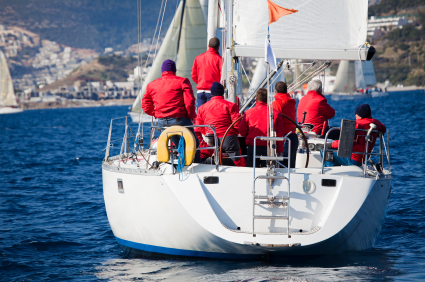
Ok, challenge accepted, I just have one sinlge day to transform a highly dysfunctional team into something new, where dialogue is possible and the motivation to change something on the current situation should last longer than a few days. I am aware that I can’t change the complete world of a team that has dysfunctional grown over the past years in one single day, even I’m not able to change their behaviors for one day, but maybe for the duration of the workshop. So the only chance I’ve had is to create an impact, a tiny little thing that could be the starting point for making a huge difference.
When I started to think about the design of the workshop, I asked myself 2 simple questions – which I always ask myself when creating a workshop, training or even just a meeting:
- Connection: how to connect participants related to their status quo?
- Content: when participants leave the workshop, what has changed, what is different for them than it was in the beginning?
Connection
Visiting…
- …a foreign city and asking the way.
- …a conference where I know absolutely nobody in person, all I know is the theme for the conference and that there’re a lot of experts in the room – so as I.
- …a grandmother and all others of the family for a family afternoon.
- …a best friend to talk about the girl you’ve just met.
- …a colleague to discuss the upcoming project.
In all of these situations, there are different kind of cennections in place, a different kind of a relationship. If you imagine you meet all these people/situations listed above, try to imagine for every single situation:
- what kind of relationship is there?
- how does this relationship influences the way I talk with the other person about the subject?
- how would the talk be different, if I simply replace the existing relationship with one of the others?

You don’t need to have an outstanding power of imagination to grasp the fact that different kind of connections will have different kind of impacts to your behavior, and even to the behavior of yours opposite. It doesn’t matter what kind of topic I talk about with somebody else, the first and biggest impact on our communication is our connection! A second important impact on our connection and communication is the environment, but the impact of the environment to our communication is a different topic – and a different post…
Content
Did you know, there is a purpose why people have meetings? Yes, it’s true! I know, for some people this sounds very surprising as they discovered meetings in the past as a complete waste of time… But there’re meetings that are different, they very often feel like little workshops and without any surprise, successful workshops, meetings and trainings have something in common, not just the environment nor the connection, no, somebody had deep and powerful thoughts about the content, about the message being transferred, the one and only piece of knowledge that makes it possible for me to see more or less of my entire world totally different than I did before.
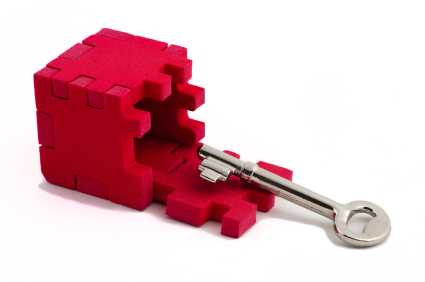
Content, like connection, is key. So, one of my most important part of work when designing and creating a new workshop or training is, to answer the question -‘ at the end of the workshop, participants will…?’
What is very interesting, recently I’ve learned that exactly this sentence is also the most important question for any public speaker when creating a new speech… I just realize what public speeches, meetings, trainings and workshops have in common…
WorkshopDesign
After evaluating all information which were available, I ended up with a design using tools and methods from LEGO® SeriousPlay and parts of the discovery-phase of Appreciative Inquiry (AI). My Agenda was to create an environment where people can overcome old habits and feel safe to try new ways of collaboration so that participants are able to create solutions in a way they never did before – with a complete new perspective and connection with each individual and the entire team, that was my mandate.
For discovering individuals, the team, it’s purpose and to create a team identity we used StrategicPlay® based on the tools and methods of LEGO® SeriousPlay. So, for the purpose of building a new connection across the entire team I choosed to use a very playful and safe environment to break the crusted over connections so that new and fresh ones can occur.
For working on the content – topics were around how the team works and behave together – I choosed the discovery phase of Appreciative Inquiry (AI). One of the core principals around AI is to concentrate – and put focus on great experiences and what people want to have more of in their life instead of concentrating on all the problems which are present and how to tackle them. As working on the content was up to the participants, I decided to choose the AI framework to create an environment where participants feel safe to share their thoughts.
You might think, phew, this won’t solve the problems they have. Sounds like another waste of time… I need to disagree! On a short term current problems won’t be solved, yes. What is much more interesting than tackling current problems is how to behave and how to avoid situations that leads to these problems – as most challenges that we call ‘problems’ have patterns in common, we start to learn a new culture, a new way how to deal with situations which are challenging, a complete new behavior! While we create a new kind of culture, we also start to deal differently with the current challenges. This norm
As we just had less than half a day left to start the content phase, I didn’t explained the whole AI approach. For time savings I just explained the challenges for an appreciative interview, what is the first part of our AI-approach.
After the interviews were held, we gathered in groups and I gave a short introduction in the upcoming process as it was about to choose a top story the groups wanted to work on and then to discover the situation of the interview, find out success factors and possible action items to get more of that in the current team.

That was more or less the whole day!
Debriefing
At the end of the workshop we gathered in a circle of chairs, by the way there were 13 ProductOwners of an international IT company.
After a harvesting of the AI-discovery phase I closed the workshop and invited the participants to give a last comment, feedback or anything they would like to say and how they would like to continue.
Most of participants liked the complete new approach they discovered over the day and they had the feeling that this was a milestone in their development phase. Some were sceptic as they discovered in the past that after such a great workshop the motivation which occured during the team intervention disappeared a few days later when people were back at their daily work. This fear clearly was present. One participant stated clearly that he has didn’t like the morning while ‘playing’ with LEGO and that for him this was a complete waste of time. But the afternoon has made it up.
It made me happy when all participants committed to continue the team development work upcoming monday – the next appointment was in place, good.
I totally respect if somebody does not like something about the framework I deliver, even if the dependencies between the exercises are not clear in detail for everybody. Important for me is that at the end, the framework made a difference, created new possibilities and opened the bridge to new perspectives and communication.
Connection first? why?
Remember the beginning of the post when I gave the examples of visiting a situation. Do you remember how your behavior changed when imagining the different situation in different relationships? Most people discover that as more powerful the connection is , as deeper and more fruitful a conversation can go. You can challenge the content, never challenge the connection!
That is why it make sense to build a connection first before I start to talk about crucial topics. That does not mean that I have to feel love or lots of sympathy for everybody! What is important is that I respect everybody in the team, I need to understand them, how they behave in different challenging situations and what kind of connection we have together so that I’m able to adapt my behavior if necessary. If such a connection exists in a team and teammembers are committed to the same targets and environment, communicate open-minded and have the courage to let the leopard change his spot, a team will learn how to fly!

Epilog
Last week I’ve received a mail from one of the participants of the workshop of this post – about 7 weeks after the event. The Team has still some problems but something crucially has changed, they work together differently than the years before. They are more respectful with each other and still work on the outcome of the workshop – towards of what they want to have more of. It seems that the fire is still burning and that people in this team have discovered that nobody is a supernumeraries, our team is star!




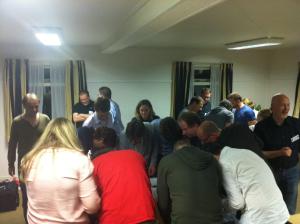

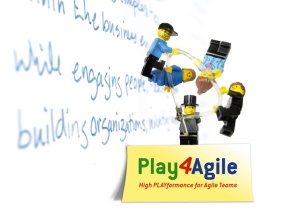
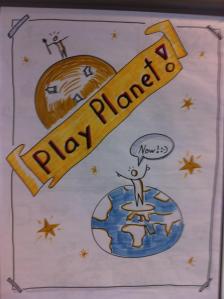
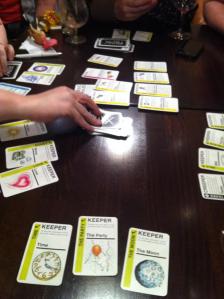
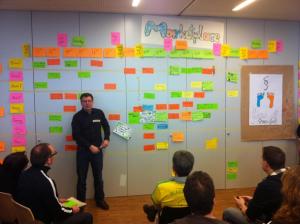
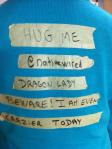
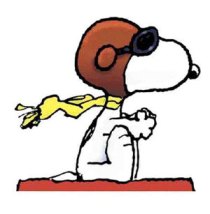 A lot of teams I met in the past worked also with avatars on their storyboard. Instead of having a name-tag on a magnet, you can use an avatar, a character from your favourite cartoon, movie or adventure. Just print out a picture of your avatar, cut it out and stick it on a magnet. Now you can use your avatar on the storyboard. Some teams put their avatars on the task they’
A lot of teams I met in the past worked also with avatars on their storyboard. Instead of having a name-tag on a magnet, you can use an avatar, a character from your favourite cartoon, movie or adventure. Just print out a picture of your avatar, cut it out and stick it on a magnet. Now you can use your avatar on the storyboard. Some teams put their avatars on the task they’
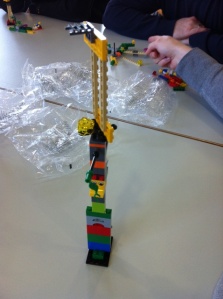











 Let participants post their solution-combinations of StickyNotes diretcly beside the relevant topic of the golf hole improvement as you can see it on the right picture! As you can see, there is just one valid solution-combination for the first improvement, non valid for the second and 4 valid solution-combinations for the third.
Let participants post their solution-combinations of StickyNotes diretcly beside the relevant topic of the golf hole improvement as you can see it on the right picture! As you can see, there is just one valid solution-combination for the first improvement, non valid for the second and 4 valid solution-combinations for the third. In April this year, Olaf Lewitz asked me if I would like to facilitate an envisioning Session with
In April this year, Olaf Lewitz asked me if I would like to facilitate an envisioning Session with  StrategicPlay® for the ALEnetwork at XP days in Madrid in May 2011. Primary, Olaf wanted to facilitate this Session by his own, but as Olaf is beside Jurgen Appelo one of the original Drivers for creating the ALEnetwork, several people asked Olaf to participate the envisioning Session and add his Ideas to a Vision for the Agile & Lean network Europe – the ALEnetwork. Thus he would not be able to facilitate it by his own. As Olaf knew, I’m also a Certified StrategicPlay® Facilitator and knew that I’m passionate about the techniques of LEGO SeriousPlay® he decided to ask me.
StrategicPlay® for the ALEnetwork at XP days in Madrid in May 2011. Primary, Olaf wanted to facilitate this Session by his own, but as Olaf is beside Jurgen Appelo one of the original Drivers for creating the ALEnetwork, several people asked Olaf to participate the envisioning Session and add his Ideas to a Vision for the Agile & Lean network Europe – the ALEnetwork. Thus he would not be able to facilitate it by his own. As Olaf knew, I’m also a Certified StrategicPlay® Facilitator and knew that I’m passionate about the techniques of LEGO SeriousPlay® he decided to ask me.
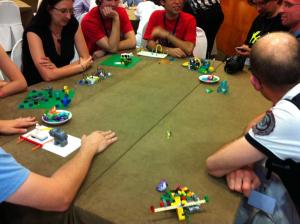




 Prepare a space for every single participant. You can use FlipCharts or use a dedicated wall-space:
Prepare a space for every single participant. You can use FlipCharts or use a dedicated wall-space:











